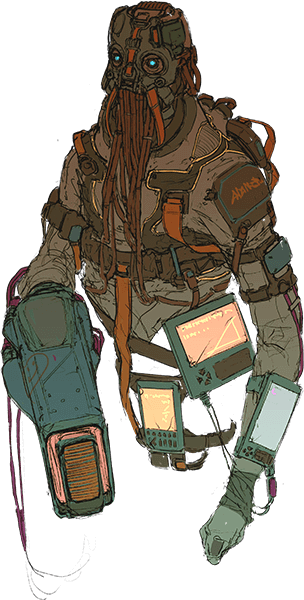Hacking
Closed Networks in the Offline World
Due to the danger of daemonic corruption, all computer networks in CHROME are closed systems that cannot be accessed remotely. A hacker must be physically present to jack into a computer system directly. Even at a physical location, most systems are not interconnected. Separate networks for security, data storage, etc., are standard.
Users can access some networks via screen-based terminals or headsets. Most high-level interaction and hacking, which require greater computational power, are done by entering VR constructs via a Cranium Processor’s direct neural link. These constructs, often referred to as ‘mesh,’ are built to model the information architecture of a private network. Their appearance is entirely dependent on the design of the network and its application.
Using direct neural link VR allows the user greater processing power to interact with the network and puts them in physical danger from security programs that can deliver damaging biofeedback. While most networks are meticulously scanned and monitored for any daemonic corruption, there is always the risk that Voidspace entities may be hidden within the network and can access a user’s neural link to infiltrate their mind and body.
System Hacking
System Hacking refers to the hacking of security systems and electronic locking mechanisms which do not require the Hacker to enter into a VR construct. Most System Hacks are performed with a standard terminal or slice box, as these systems are not complex enough to support VR. System Hacking does not subject the hacker to potential physical harm from biofeedback or risk of daemonic corruption.
To hack a System, the Operator rolls a series of Intellect Checks. The System’s rating determines the number of successes necessary to hack the system.
- A counts as two (2) successes against the System.
- On a Failure, any previous successes are lost, and the System resets.
- On a , the System will lock down and not allow for further hacking. This may also trigger additional security measures in specific systems.
| System Ratings | Required Successes |
|---|---|
| Basic | 1 |
| Difficult | 2 |
| Master | 3 |

Network Hacking
Network Hacking requires the Hacker to enter into a VR mesh construct via a Cranium Processor. The increased computational power of the neural link allows the hacker to navigate, dismantle, search, or destroy these systems in ways that standard terminal or headset users cannot. Conversely, it puts the hacker in danger of physical harm from security systems and potentially daemons.
To hack a Network, the Operator rolls a series of using their Intellect stat against the Network rating. The Network’s rating also determines the number of successes necessary to hack the system.
- A counts as two (2) successes against the Network.
- On a Failure, the Network will cause biofeedback damage to the Operator.
- On a , the biofeedback damage is doubled, and the Operator is forcibly disconnected from the Network. This may also trigger additional security measures in specific networks.
- An Operator’s score does NOT reduce biofeedback damage.
| Network Rating | Required Successes | Biofeedback Damage |
|---|---|---|
| Basic (30) | 1 | Standard (2) |
| Difficult (50) | 2 | Massive (4) |
| Master (70) | 3 | Deadly (6) |